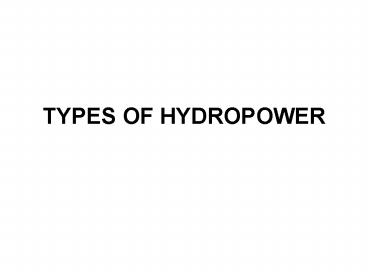TYPES OF HYDROPOWER - PowerPoint PPT Presentation
1 / 35
Title:
TYPES OF HYDROPOWER
Description:
TYPES OF HYDROPOWER Terminology (Jargon) Head Water must fall from a higher elevation to a lower one to release its stored energy. The difference between these ... – PowerPoint PPT presentation
Number of Views:576
Avg rating:3.0/5.0
Title: TYPES OF HYDROPOWER
1
TYPES OF HYDROPOWER
2
Terminology (Jargon)
- Head
- Water must fall from a higher elevation to a
lower one to release its stored energy. - The difference between these elevations (the
water levels in the forebay and the tailbay) is
called head - Dams three categories
- high-head (800 or more feet)
- medium-head (100 to 800 feet)
- low-head (less than 100 feet)
- Power is proportional to the product of head
x flow
3
Scale of Hydropower Projects
- Large-hydro
- More than 100 MW feeding into a large electricity
grid - Medium-hydro
- 15 - 100 MW usually feeding a grid
- Small-hydro
- 1 - 15 MW - usually feeding into a grid
- Mini-hydro
- Above 100 kW, but below 1 MW
- Either stand alone schemes or more often feeding
into the grid - Micro-hydro
- From 5kW up to 100 kW
- Usually provided power for a small community or
rural industry in remote areas away from the
grid. - Pico-hydro
- From a few hundred watts up to 5kW
- Remote areas away from the grid.
4
Types of Hydroelectric Installation
5
Meeting Peak Demands
- Hydroelectric plants
- Start easily and quickly and change power output
rapidly - Complement large thermal plants (coal and
nuclear), which are most efficient in serving
base power loads. - Save millions of barrels of oil
6
Types of Systems
- Impoundment
- Hoover Dam, Grand Coulee
- Diversion or run-of-river systems
- Niagara Falls
- Most significantly smaller
- Pumped Storage
- Two way flow
- Pumped up to a storage reservoir and returned to
a lower elevation for power generation - A mechanism for energy storage, not net energy
production
7
Conventional Impoundment Dam
8
ExampleHoover Dam (US)
9
Diversion (Run-of-River) Hydropower
10
ExampleDiversion Hydropower (Tazimina, Alaska)
11
Micro Run-of-River Hydropower
12
Micro Hydro Example
Used in remote locations in northern Canada
13
Pumped Storage Schematic
14
Pumped Storage System
15
ExampleCabin Creek Pumped Hydro (Colorado)
- Completed 1967
- Capacity 324 MW
- Two 162 MW units
- Purpose energy storage
- Water pumped uphill at night
- Low usage excess base load capacity
- Water flows downhill during day/peak periods
- Helps Xcel to meet surge demand
- E.g., air conditioning demand on hot summer days
- Typical efficiency of 70 85
16
Pumped Storage Power Spectrum
17
Turbine Design
- Francis TurbineKaplan TurbinePelton
TurbineTurgo TurbineNew Designs
18
Types of Hydropower Turbines
19
Classification of Hydro Turbines
- Reaction Turbines
- Derive power from pressure drop across turbine
- Totally immersed in water
- Angular linear motion converted to shaft power
- Propeller, Francis, and Kaplan turbines
- Impulse Turbines
- Convert kinetic energy of water jet hitting
buckets - No pressure drop across turbines
- Pelton, Turgo, and crossflow turbines
20
Schematic of Francis Turbine
21
Francis Turbine Cross-Section
22
Small Francis Turbine Generator
23
Francis Turbine Grand Coulee Dam
24
Fixed-Pitch Propeller Turbine
25
Kaplan Turbine Schematic
26
Kaplan Turbine Cross Section
27
Suspended Power, Sheeler, 1939
28
Vertical Kaplan Turbine Setup
29
Horizontal Kaplan Turbine
30
Pelton Wheel Turbine
31
Turgo Turbine
32
Turbine Design Ranges
- Kaplan
- Francis
- Pelton
- Turgo
- 2 lt H lt 40
- 10 lt H lt 350
- 50 lt H lt 1300
- 50 lt H lt 250
- (H head in meters)
33
Turbine Ranges of Application
34
Turbine Design Recommendations
Head Pressure Head Pressure Head Pressure
High Medium Low
Impulse Pelton Turgo Multi-jet Pelton Crossflow Turgo Multi-jet Pelton Crossflow
Reaction Francis Pump-as-Turbine Propeller Kaplan
35
Fish Friendly Turbine Design































